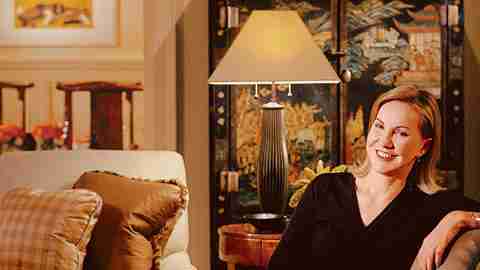View Slideshow

Our goal, to put it simply, was to out-Candela Candela," says Kevin Lichten, the architect who, working in close collaboration with the designer Sandra Nunnerley, oversaw the rehabilitation of a classic prewar apartment on the upper reaches of Park Avenue. "Gifted though Rosario Candela was, there were buildings he designed for developers where the individual apartments lacked a certain amplitude, or flourish. This tends to happen when you build without a specific client in mind. We thought of ourselves as Candela designing for this actual family—we tried to see them, and the apartment, through his eyes."
The clients, a professional couple seeking a base in New York after many years in Hong Kong, approached Nunnerley and Lichten with a well-considered program. Because they would be supervising the work from afar, they wanted two strong—and strong-minded —design professionals who would challenge each other to do their best work. The much-invoked words understated elegance were offered as a design dictum, but in this case they came with an unexpected specificity: "We wanted the apartment to reflect our years in the East," says the wife. "The aesthetic is very meaningful to us. There's a subtlety and a cleanliness to Asian furniture, ceramics and art that we grew accustomed to in Hong Kong and hoped to integrate into our home in New York."
"We wanted the apartment to reflect our years in the East," says the wife. "The aesthetic is very meaningful to us."
At the same time, the couple and their three children needed the apartment to accommodate a busy urban family life. Predictably, this meant that they needed a family room and a welcoming kitchen, places where both the wife and the husband could work from home, and a variety of technological amenities and creature comforts that were unheard of in the early 20th century but, at a certain level, were fundamental in the 21st. Yet modern though they are, the family has a policy that is a throwback to the apartment's origins: They dine together formally whenever possible, in a room used only for this purpose, and without cooking chores or TV intruding on their cherished time together.
What all this boded for the apartment was a rethinking from the walls in. In theory it meant that room assignment, size, proportion and detail were all up for grabs; in practice, the butler's pantry and multiple servants' quarters were opened up into a family room, a more capacious kitchen and a single housekeeper's room; a paneled library was installed; moldings everywhere were "taken up a notch," as Nunnerley puts it; and, naturally, systems were updated throughout.
For Nunnerley, what set this project apart was the close interplay between architecture, design and the clients' collection. "I must confess it's one of my favorite things, to work with existing furniture," she says. "It gives you a point of view to begin with and makes the home much more personal and vital in the end." Indeed, such was the clients' thoroughness that, at Nunnerley's request, they prepared a catalogue of the Asian furniture they had found in Hong Kong and the European furniture they had inherited, enabling her to tighten the relationship between the rooms and the objects that stood in them.
Consider the living room, for example, which is anchored by a pair of Chinese cabinets the couple found in Hong Kong. "Kevin and I fitted them very carefully into a wall that serves two purposes. It provides a dramatic frame to the dining room, and it balances the fireplace wall, which has its own strong anchor in the 19th-century mantel."
Even with these clever calculations, however, a Nunnerley interior is about more than deft placement and precise proportion. She is uninterested in making period re-creations. Her rooms are modern in the way the furniture is conceived and combined and in the way they confidently draw from various epochs: The mantel, for instance, acquires a sculptural quality when it is paired with a crisp 1940s mirror and a cluster of 1940s French vases. "Rooms that are all one thing or another," she says firmly, "are dead."
The much-used dining room further demonstrates the apartment's prevailing, and close, collaborative spirit: When Nunnerley saw the couple's striking 18th-century yoke-back Chinese chairs, she saw to it that the wainscoting was pitched high enough so that no horizontal line would bisect their impeccably graphic forms. This kind of subtly graceful manipulation of the vocabulary of interior design is a perfect example of why clients turn to knowing professionals.
Noted for her sharply tailored interiors, Nunnerley recognizes when to leave well enough alone. The dramatic Chinese canopy bed required little embellishment, except perhaps for a well-chosen Matisse work on paper of—what else?—a nude in repose. The good-size entrance hall wanted little more than a graphic marble floor and a strong Baltic table. The husband's library, by contrast, needed to have its rich cabinetry arrayed with objects that could meet the woodwork in quality and presence—hence the collection of Ming ceramic equestrians that she helped her clients assemble.
Back to "understated elegance": Are those really the most apt words? "I'd say Zen,' myself, if it didn't suggest something more spartan than we ended up with here," Nunnerley observes. "How about marrying East with West'? Or refined tranquillity'? That summarizes the clients—and their apartment too."
